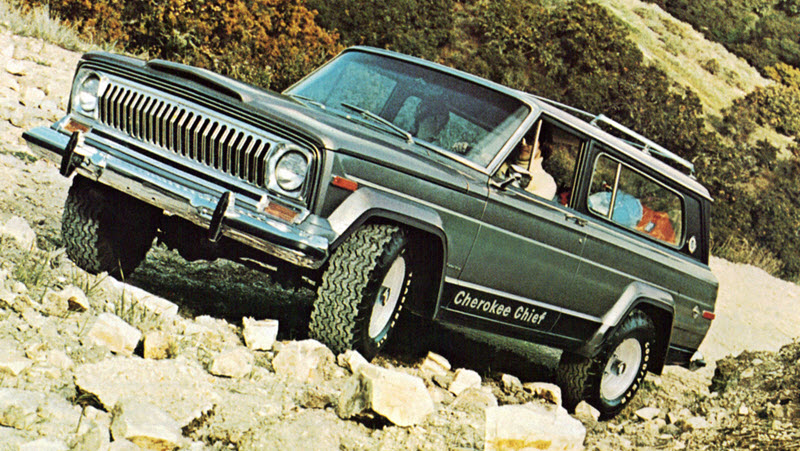Jeep Cherokee (SJ)
The Jeep Cherokee SJ series was a full-size SUV produced by Jeep from 1974 through 1983. It was largely based on the Jeep Wagoneer, but was offered as two-door only until 1977. The Jeep Cherokee was considered a sportier and more fun version of the Wagoneer. (The Wagoneer was seen largely as a reliable mode of transportation for families with kids.)
Instead of a C-pillar, the Jeep Cherokee SJ had a D-pillar and a long, fixed rear side window. (If you wanted the window to have a flip-out section, that was available as an option.)
Together with the Jeep Wagoneer and the J-Truck, the Jeep Cherokee SJ still shares the record for largest engine ever offered in a Jeep. When buying an SJ, you could opt for a 401 cu in (6.6 L) AMC V8 4-barrel where the displacement surpassed even that of the SRT-8 Grand Cherokee’s 392 cu in (6.4 L) Hemi.
In February 1974, Four Wheeler Magazine handed out its very first Achievement Award and it went to the Jeep Cherokee SJ series. (This is the award that eventually turned into the annual Four Wheeler of the Year award.)

Short facts about the Jeep Cherokee (SJ)
|
Manufacturer |
Jeep (American Motors) |
|---|---|
|
Production |
1974–1983 |
|
Assembly |
|
|
Class |
Full-size SUV |
|
Body style |
2-door wagon |
|---|---|
|
Platform |
SJ |
|
Engine |
|
|
Transmission |
|
|
Wheelbase |
108.7 in (2,761 mm) |
|
Length |
186.4 in (4,735 mm) |
|
Width |
74.8 in (1,900 mm) |
|
Height |
66.4 in (1,687 mm) |
|
Curb weight |
4,514 lb (2,048 kg) |
|
Successor |
Jeep Cherokee (XJ) |
|---|
Configurations
Initially, the Jeep Cherokee SJ was only available as “narrow track”. You could either go for the basic Model 16 or open up your purse for the more expensive Model 17.
Later, additional trim levels were added, such as the Sport, Chief, Golden Eagle, Golden Hawk, Laredo, and Pioneer.
The Chief package didn’t just come with trim changes; it would also give you larger fenders and wider axles that could accomodate larger tires for drivers seeking extra off-road capabilities. (Not avaialable for 4-door models.)
The Golden Eagle and Golden Hawk were both marketed as graphics packages, while the high-end Laredo was more focused on upholstery. The Golden Eangle was very similar to the Chief, but with denim for the interior, gold painted steel wheels and a prominent golden eagle decal on the hood.
Performance
Examples of available engines:
| Engine | Info |
| 258 cu in (4.2 L) AMC I6 | 110 hp (82 kW; 112 PS) 258 cu in (4.2 L) inline six-cylinder |
|
175 hp (130 kW; 177 PS) 360 cu in (5.9 L) V8 with two-barrel carburetor and
high nickel content block |
|
195 hp (145 kW; 198 PS) four-barrel 360
with high nickel content block |
|
High nickel content block
Forged crankshaft Forged connecting rods |
|
(very rare) |
When the Cherokee SJ was fitted with the 6.6 L V8 engine, it would be faster than pretty much every other 4WD vehicles in its class. On the highway, it could make over 100 miles per hour (approximately 160 km/h). The displacement was actually bigger than that of the SRT-8 Gran Cherokee’s 392 cu in (6.4 L) Hemi.
Gear box
Throughout the years, a T-18/T-18a four-speed manual gearbox was standard for the Jeep Cherokee SJ.
Examples of options:
- General Motor’s Turbo-Hydromatic TH400 (intended for 3/4 and 1-ton trucks, but sometimes fitted to the Cherokee SJ SUV). This option was available up towards the end of the 1970s.
- Chrysler’s TorqueFlite 727. This option replaced the TH400 option.
In Australia
Since you drive on the left side of the road in Australia, the norm is to have the steering wheel on the right hand side of the car. To accomodate, Jeep assembled right-side steered Cherokee SJ:s in Brisbane, Australia from 1981 and onwards.
At first, fully built SUV:s were shipped to Brisbane where they were partly taken apart to be turned into right-hand-drive. Later, knock-down kits were imported instead and fully assembled in Australia.